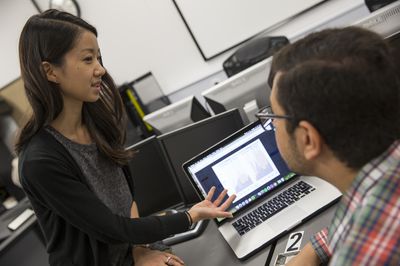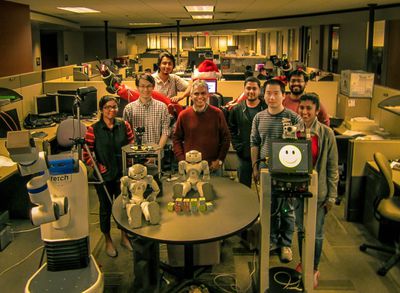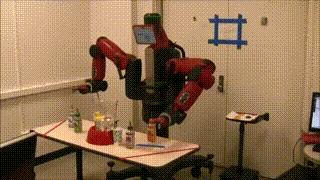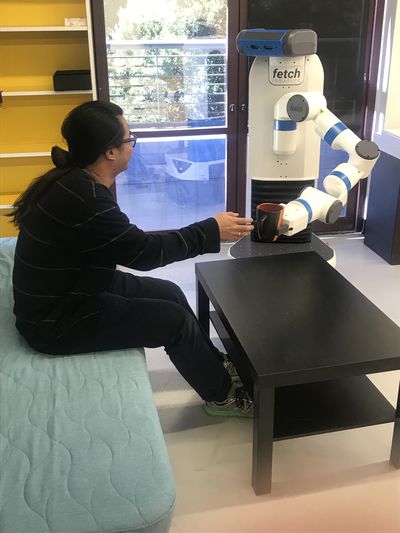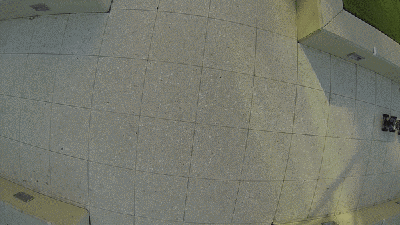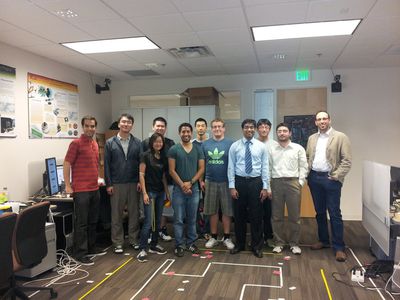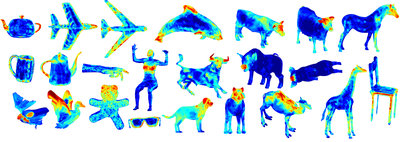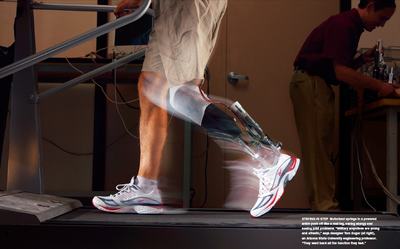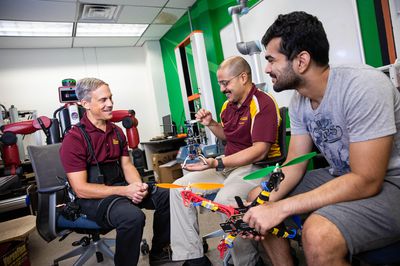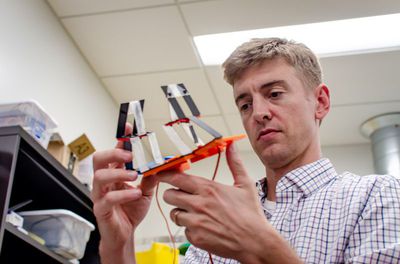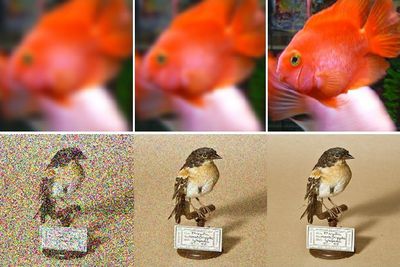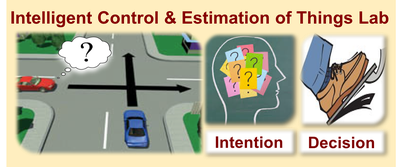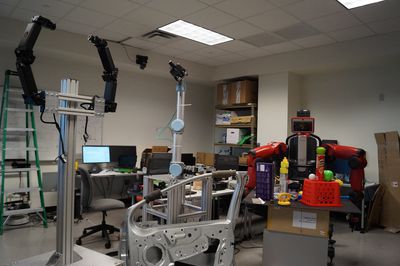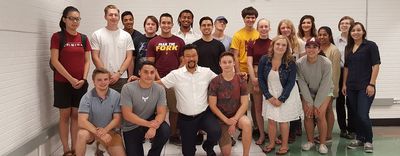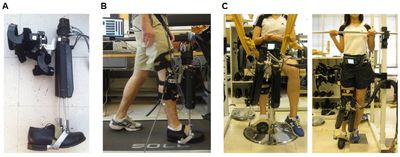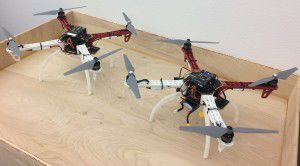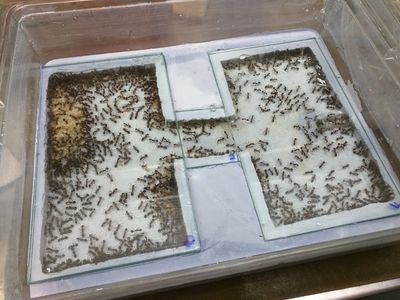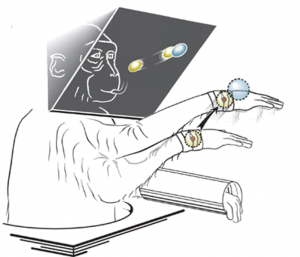Research Labs
Learn about the work being done across schools
Filter by Topic: All AI-and-learning Design Formal methods Human System Measurement Human-Robot Medical Robotics Neural Soft Robotics Vision human-robot interaction natural language grounding AI-and-learning Automation Bio-robotics Controls Design Dynamics Human-Machine Teaming Human-Robot Job-Design Mechatronics Neural Robot learning Safety Sociotechnical-Systems Vision
Filter by School: All AME ECEE Hugh-Downs-School MSN POLY SBHSE SCAI SEMTE TPS
All
ADAPT Lab
POLY
The Automation Design Advancing People and Technology (ADAPT) Laboratory conducts research to understand how automation can improve productivity, quality, and safety in our human world.
Automation Human-Robot Job-Design Safety Sociotechnical-Systems
AI Lab (Yochan)
SCAI
Planning, decision-making and collaboration in human-aware AI systems, and human-robot teams.
Active Perception Group
SCAI
The Active Perception Group (APG) approaches the following quests from the angle of visual perception: Why do robots perceive, how do robots perceive, what do robots perceive and when do robots perceive, to understand us?
AI-and-learning Human-Robot Neural Vision
Autonomous Agents and Intelligent Robots (AAIR) Lab
SCAI
Principles and applications of sequential decision making under uncertainty for robotics, including mobile manipulation, household robotics and robot asisstants that reason, act and learn over long time horizons to assist humans.
AI-and-learning Controls Human-Robot Neural
Autonomous Collective Systems Laboratory
SEMTE
The lab applies rigorous techniques of modeling, analysis, control, and optimization to design agent behaviors that provably achieve target objectives, using both virtual and small-scale physical testbeds for validation.
Bio-robotics Controls Dynamics Human-Robot
BIRTH Lab
SEMTE
The mission of the Bio-Inspired Robotics, Technology, and Healthcare lab (BIRTH lab) is to give "birth" to new robotic technologies inspired by nature.
Medical Robotics Soft Robotics Bio-robotics Design Dynamics Mechatronics
CERTT Lab & CHART Labs
TPS
CERTT and CHART Labs study human-machine teaming in the context of synthetic task environments and often using the Wizard of Oz paradigm, inspired by the rich literature on human teaming and experts on human-animal teaming
Human System Measurement Human-Machine Teaming
Compiler-Microarchitecture Lab(CML)
SCAI
Precision timing and synchronized actions are needed for Cyber-Physical Systems. CML investigates methods by which computing systems can become more time-predictable, and can share a common notion of time.
Cooperative Robotic Systems (CRS) laboratory
SCAI
The research agenda of the CRS laboratory includes the development of novel modeling methods, robust decision making algorithms, as well as system integration and evaluation for cooperative and intelligent agents.
AI-and-learning Human-Robot
Cyber-Physical Systems Lab
SCAI
The CPSLab is working on problems related to the foundations of Cyber-Physical Systems (CPS). Particular focus is given to developing theories and tools for model based development of CPS.
AI-and-learning Controls Dynamics
Design Informatics Lab
SEMTE
The lab focuses on computational and crowdsourcing tools that will renovate engineering and industrial design activities.
AI-and-learning Design
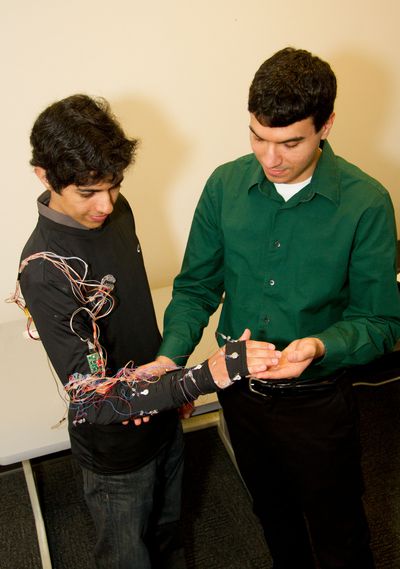
HAPT-X Laboratory
MSN
The HAPT-X Laboratory at Arizona State University is an interdisciplinary research laboratory exploring state-of-the-art haptic interfaces for human augmentation, sensory substitution, and multimodal integration. Our application focuses include assistive technology for individuals with disabilities, rehabilitation, and health and wellness.
AI-and-learning Design Human-Robot Mechatronics Vision
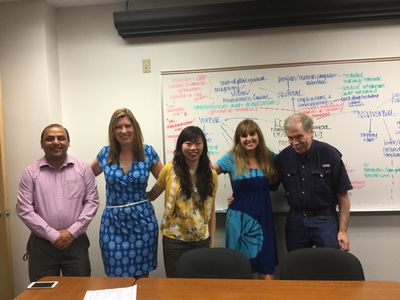
Human Communication Robotics Group
Hugh-Downs-School
The lab focuses on how human-machine interaction can affect religiosity, how robots will both disrupt and enhance romantic relationships, the importance of cultural sensitivity addressing the disparities that robotics will bring.
Design Human-Robot
Human Machine Integration Laboratory
MSN
Design and build wearable robotic systems.
Bio-robotics Controls Design Mechatronics
Human Machine Integration Laboratory
MSN
We work in dynamics and control of robots and physiological sensing
Bio-robotics Controls Design Mechatronics
IDEAlab
MSN
The lab's focus is to develop new tools for designing robots by pairing emerging fabrication techniques and new materials with analytical and simulation-based methods for understanding the behavior of these complex systems
Design Dynamics Mechatronics
Image, Video, & Usability (IVU) Lab
ECEE
R&D on sensing, image/video processing, computer vision, machine learning/deep learning, perception-based processing, human-systems integration, data compression and transmission.
AI-and-learning Human-Robot Neural Vision
Intelligent Control and Estimation of Things (ICE-T) Laboratory
SEMTE
The ICE-T Lab focuses on the control, estimation, identification and analysis of autonomous multi-agent systems,intelligent robots and cyber-physical systems with an emphasis on theory and tool development for reliability, robustness, security and safety.
AI-and-learning Controls Dynamics Human-Robot
Interactive Robotics Laboratory
SCAI
The lab explores the intersection of robotics, artificial intelligence, and human-robot interaction for the development of machine learning methods that allow humanoid robots to behave in an intelligent and autonomous manner.
AI-and-learning Controls Human-Robot Neural Vision
IoT and Robotics Education Lab
SCAI
Develop educational materials for teaching computational thinking, IoT, robotics, and visual programming.
Controls Design
Laboratory for Power Electronics Systems (LPES)
POLY
The objective of LPES is to perform multidimensional co-design and optimization of power electronic systems for a variety of applications such as: transportation electrification, data centers etc. We are pursuing a multi-disciplinary research agenda merging thermal and reliability constraints with power electronics design for the research problems that are attempting to achieve challenging targets for multiple performance metrics (such as: power density, efficiency, and reliability, etc).
Controls Design
Locomotion Research Laboratory
SBHSE
An interdisciplinary research laboratory capable of addressing the needs of the older adults by focusing on fall prevention utilizing mobile, wireless, ubiquitous and gait sensing technologies.
AI-and-learning Dynamics
Neuromuscular Control and Human Robotics Laboratory (NeuroRobotics Lab)
SEMTE
Aiming to identify mechanisms underlying human neuromuscular control, innovate physical human-robot interaction by incorporating key principles in human motor control into robotics, and advance robot-aided neurorehabilitation.
Bio-robotics Controls Design Mechatronics Neural
People and Robots Lab (PeRL)
AME
The People and Robot Lab's long-term goal is to facilitate the coordination, communication, coexistence, and mutual adaptation between robots and humans in dynamic, uncertain, adversarial, and multi-goal environments.
Human-Robot Neural Vision AI-and-learning
Robotics and Intelligent Systems Laboratory
MSN
Lab focusing on developing control and learning algorithms for future robots to efficiently collaborate with human users and autonomously operate in challenging environments
Human-Robot AI-and-learning Controls Mechatronics
Robotics for People (R4P) Lab
SCAI
The R4P lab develops learning methods to help robots collaborate with humans.
human-robot interaction natural language grounding Robot learning
Science and Engineering of Autonomous Decision-making Systems (SEADS) Lab
SCAI
Interdisciplinary laboratory focused on the analysis of natural systems that solve complex problems and the design of artificial systems (robotics and automation systems) that are similarly flexible, adaptive, and scalable.
AI-and-learning Bio-robotics Controls Dynamics Neural
Touch Experience and Action Learning (TEAL)
SCAI
The TEAL lab explores topics at the intersection of haptics, social robotics, and human-computer interaction. We study how users interact with and make sense of haptic feedback from wearable devices and robots and build hardware and software tools that facilitate creation and adaptation of haptic interactions by a wide range of users.
AI-and-learning Design Human-Robot
Visuomotor Learning Lab
SBHSE
The lab focuses on using a combination of human psychophysical experiments, neurophysiological experiments, and computational modeling to pursue its research interests.
Bio-robotics Neural
Zhe Xu Lab
SEMTE
The objective of the lab is to address the challenges of AI-based autonomous systems by explaining, guiding and verifying autonomous systems, taking into account limited availability of simulated and real data, the expressivity of high-level knowledge representations and the uncertainties of the underlying model.
AI-and-learning Formal methods Controls
AI-and-learning
Touch Experience and Action Learning (TEAL)
SCAI
The TEAL lab explores topics at the intersection of haptics, social robotics, and human-computer interaction. We study how users interact with and make sense of haptic feedback from wearable devices and robots and build hardware and software tools that facilitate creation and adaptation of haptic interactions by a wide range of users.
AI-and-learning Design Human-Robot
Zhe Xu Lab
SEMTE
The objective of the lab is to address the challenges of AI-based autonomous systems by explaining, guiding and verifying autonomous systems, taking into account limited availability of simulated and real data, the expressivity of high-level knowledge representations and the uncertainties of the underlying model.
AI-and-learning Formal methods Controls
Design
Touch Experience and Action Learning (TEAL)
SCAI
The TEAL lab explores topics at the intersection of haptics, social robotics, and human-computer interaction. We study how users interact with and make sense of haptic feedback from wearable devices and robots and build hardware and software tools that facilitate creation and adaptation of haptic interactions by a wide range of users.
AI-and-learning Design Human-Robot
Formal methods
Zhe Xu Lab
SEMTE
The objective of the lab is to address the challenges of AI-based autonomous systems by explaining, guiding and verifying autonomous systems, taking into account limited availability of simulated and real data, the expressivity of high-level knowledge representations and the uncertainties of the underlying model.
AI-and-learning Formal methods Controls
Human System Measurement
CERTT Lab & CHART Labs
TPS
CERTT and CHART Labs study human-machine teaming in the context of synthetic task environments and often using the Wizard of Oz paradigm, inspired by the rich literature on human teaming and experts on human-animal teaming
Human System Measurement Human-Machine Teaming
Human-Robot
People and Robots Lab (PeRL)
AME
The People and Robot Lab's long-term goal is to facilitate the coordination, communication, coexistence, and mutual adaptation between robots and humans in dynamic, uncertain, adversarial, and multi-goal environments.
Human-Robot Neural Vision AI-and-learning
Robotics and Intelligent Systems Laboratory
MSN
Lab focusing on developing control and learning algorithms for future robots to efficiently collaborate with human users and autonomously operate in challenging environments
Human-Robot AI-and-learning Controls Mechatronics
Medical Robotics
BIRTH Lab
SEMTE
The mission of the Bio-Inspired Robotics, Technology, and Healthcare lab (BIRTH lab) is to give "birth" to new robotic technologies inspired by nature.
Medical Robotics Soft Robotics Bio-robotics Design Dynamics Mechatronics
Neural
People and Robots Lab (PeRL)
AME
The People and Robot Lab's long-term goal is to facilitate the coordination, communication, coexistence, and mutual adaptation between robots and humans in dynamic, uncertain, adversarial, and multi-goal environments.
Human-Robot Neural Vision AI-and-learning
Soft Robotics
BIRTH Lab
SEMTE
The mission of the Bio-Inspired Robotics, Technology, and Healthcare lab (BIRTH lab) is to give "birth" to new robotic technologies inspired by nature.
Medical Robotics Soft Robotics Bio-robotics Design Dynamics Mechatronics
Vision
People and Robots Lab (PeRL)
AME
The People and Robot Lab's long-term goal is to facilitate the coordination, communication, coexistence, and mutual adaptation between robots and humans in dynamic, uncertain, adversarial, and multi-goal environments.
Human-Robot Neural Vision AI-and-learning
human-robot interaction
Robotics for People (R4P) Lab
SCAI
The R4P lab develops learning methods to help robots collaborate with humans.
human-robot interaction natural language grounding Robot learning
natural language grounding
Robotics for People (R4P) Lab
SCAI
The R4P lab develops learning methods to help robots collaborate with humans.
human-robot interaction natural language grounding Robot learning
AI-and-learning
Active Perception Group
SCAI
The Active Perception Group (APG) approaches the following quests from the angle of visual perception: Why do robots perceive, how do robots perceive, what do robots perceive and when do robots perceive, to understand us?
AI-and-learning Human-Robot Neural Vision
Autonomous Agents and Intelligent Robots (AAIR) Lab
SCAI
Principles and applications of sequential decision making under uncertainty for robotics, including mobile manipulation, household robotics and robot asisstants that reason, act and learn over long time horizons to assist humans.
AI-and-learning Controls Human-Robot Neural
Cooperative Robotic Systems (CRS) laboratory
SCAI
The research agenda of the CRS laboratory includes the development of novel modeling methods, robust decision making algorithms, as well as system integration and evaluation for cooperative and intelligent agents.
AI-and-learning Human-Robot
Cyber-Physical Systems Lab
SCAI
The CPSLab is working on problems related to the foundations of Cyber-Physical Systems (CPS). Particular focus is given to developing theories and tools for model based development of CPS.
AI-and-learning Controls Dynamics
Design Informatics Lab
SEMTE
The lab focuses on computational and crowdsourcing tools that will renovate engineering and industrial design activities.
AI-and-learning Design

HAPT-X Laboratory
MSN
The HAPT-X Laboratory at Arizona State University is an interdisciplinary research laboratory exploring state-of-the-art haptic interfaces for human augmentation, sensory substitution, and multimodal integration. Our application focuses include assistive technology for individuals with disabilities, rehabilitation, and health and wellness.
AI-and-learning Design Human-Robot Mechatronics Vision
Image, Video, & Usability (IVU) Lab
ECEE
R&D on sensing, image/video processing, computer vision, machine learning/deep learning, perception-based processing, human-systems integration, data compression and transmission.
AI-and-learning Human-Robot Neural Vision
Intelligent Control and Estimation of Things (ICE-T) Laboratory
SEMTE
The ICE-T Lab focuses on the control, estimation, identification and analysis of autonomous multi-agent systems,intelligent robots and cyber-physical systems with an emphasis on theory and tool development for reliability, robustness, security and safety.
AI-and-learning Controls Dynamics Human-Robot
Interactive Robotics Laboratory
SCAI
The lab explores the intersection of robotics, artificial intelligence, and human-robot interaction for the development of machine learning methods that allow humanoid robots to behave in an intelligent and autonomous manner.
AI-and-learning Controls Human-Robot Neural Vision
Locomotion Research Laboratory
SBHSE
An interdisciplinary research laboratory capable of addressing the needs of the older adults by focusing on fall prevention utilizing mobile, wireless, ubiquitous and gait sensing technologies.
AI-and-learning Dynamics
People and Robots Lab (PeRL)
AME
The People and Robot Lab's long-term goal is to facilitate the coordination, communication, coexistence, and mutual adaptation between robots and humans in dynamic, uncertain, adversarial, and multi-goal environments.
Human-Robot Neural Vision AI-and-learning
Robotics and Intelligent Systems Laboratory
MSN
Lab focusing on developing control and learning algorithms for future robots to efficiently collaborate with human users and autonomously operate in challenging environments
Human-Robot AI-and-learning Controls Mechatronics
Science and Engineering of Autonomous Decision-making Systems (SEADS) Lab
SCAI
Interdisciplinary laboratory focused on the analysis of natural systems that solve complex problems and the design of artificial systems (robotics and automation systems) that are similarly flexible, adaptive, and scalable.
AI-and-learning Bio-robotics Controls Dynamics Neural
Automation
ADAPT Lab
POLY
The Automation Design Advancing People and Technology (ADAPT) Laboratory conducts research to understand how automation can improve productivity, quality, and safety in our human world.
Automation Human-Robot Job-Design Safety Sociotechnical-Systems
Bio-robotics
Autonomous Collective Systems Laboratory
SEMTE
The lab applies rigorous techniques of modeling, analysis, control, and optimization to design agent behaviors that provably achieve target objectives, using both virtual and small-scale physical testbeds for validation.
Bio-robotics Controls Dynamics Human-Robot
BIRTH Lab
SEMTE
The mission of the Bio-Inspired Robotics, Technology, and Healthcare lab (BIRTH lab) is to give "birth" to new robotic technologies inspired by nature.
Medical Robotics Soft Robotics Bio-robotics Design Dynamics Mechatronics
Human Machine Integration Laboratory
MSN
Design and build wearable robotic systems.
Bio-robotics Controls Design Mechatronics
Human Machine Integration Laboratory
MSN
We work in dynamics and control of robots and physiological sensing
Bio-robotics Controls Design Mechatronics
Neuromuscular Control and Human Robotics Laboratory (NeuroRobotics Lab)
SEMTE
Aiming to identify mechanisms underlying human neuromuscular control, innovate physical human-robot interaction by incorporating key principles in human motor control into robotics, and advance robot-aided neurorehabilitation.
Bio-robotics Controls Design Mechatronics Neural
Science and Engineering of Autonomous Decision-making Systems (SEADS) Lab
SCAI
Interdisciplinary laboratory focused on the analysis of natural systems that solve complex problems and the design of artificial systems (robotics and automation systems) that are similarly flexible, adaptive, and scalable.
AI-and-learning Bio-robotics Controls Dynamics Neural
Visuomotor Learning Lab
SBHSE
The lab focuses on using a combination of human psychophysical experiments, neurophysiological experiments, and computational modeling to pursue its research interests.
Bio-robotics Neural
Controls
Autonomous Agents and Intelligent Robots (AAIR) Lab
SCAI
Principles and applications of sequential decision making under uncertainty for robotics, including mobile manipulation, household robotics and robot asisstants that reason, act and learn over long time horizons to assist humans.
AI-and-learning Controls Human-Robot Neural
Autonomous Collective Systems Laboratory
SEMTE
The lab applies rigorous techniques of modeling, analysis, control, and optimization to design agent behaviors that provably achieve target objectives, using both virtual and small-scale physical testbeds for validation.
Bio-robotics Controls Dynamics Human-Robot
Cyber-Physical Systems Lab
SCAI
The CPSLab is working on problems related to the foundations of Cyber-Physical Systems (CPS). Particular focus is given to developing theories and tools for model based development of CPS.
AI-and-learning Controls Dynamics
Human Machine Integration Laboratory
MSN
Design and build wearable robotic systems.
Bio-robotics Controls Design Mechatronics
Human Machine Integration Laboratory
MSN
We work in dynamics and control of robots and physiological sensing
Bio-robotics Controls Design Mechatronics
Intelligent Control and Estimation of Things (ICE-T) Laboratory
SEMTE
The ICE-T Lab focuses on the control, estimation, identification and analysis of autonomous multi-agent systems,intelligent robots and cyber-physical systems with an emphasis on theory and tool development for reliability, robustness, security and safety.
AI-and-learning Controls Dynamics Human-Robot
Interactive Robotics Laboratory
SCAI
The lab explores the intersection of robotics, artificial intelligence, and human-robot interaction for the development of machine learning methods that allow humanoid robots to behave in an intelligent and autonomous manner.
AI-and-learning Controls Human-Robot Neural Vision
IoT and Robotics Education Lab
SCAI
Develop educational materials for teaching computational thinking, IoT, robotics, and visual programming.
Controls Design
Laboratory for Power Electronics Systems (LPES)
POLY
The objective of LPES is to perform multidimensional co-design and optimization of power electronic systems for a variety of applications such as: transportation electrification, data centers etc. We are pursuing a multi-disciplinary research agenda merging thermal and reliability constraints with power electronics design for the research problems that are attempting to achieve challenging targets for multiple performance metrics (such as: power density, efficiency, and reliability, etc).
Controls Design
Neuromuscular Control and Human Robotics Laboratory (NeuroRobotics Lab)
SEMTE
Aiming to identify mechanisms underlying human neuromuscular control, innovate physical human-robot interaction by incorporating key principles in human motor control into robotics, and advance robot-aided neurorehabilitation.
Bio-robotics Controls Design Mechatronics Neural
Robotics and Intelligent Systems Laboratory
MSN
Lab focusing on developing control and learning algorithms for future robots to efficiently collaborate with human users and autonomously operate in challenging environments
Human-Robot AI-and-learning Controls Mechatronics
Science and Engineering of Autonomous Decision-making Systems (SEADS) Lab
SCAI
Interdisciplinary laboratory focused on the analysis of natural systems that solve complex problems and the design of artificial systems (robotics and automation systems) that are similarly flexible, adaptive, and scalable.
AI-and-learning Bio-robotics Controls Dynamics Neural
Zhe Xu Lab
SEMTE
The objective of the lab is to address the challenges of AI-based autonomous systems by explaining, guiding and verifying autonomous systems, taking into account limited availability of simulated and real data, the expressivity of high-level knowledge representations and the uncertainties of the underlying model.
AI-and-learning Formal methods Controls
Design
BIRTH Lab
SEMTE
The mission of the Bio-Inspired Robotics, Technology, and Healthcare lab (BIRTH lab) is to give "birth" to new robotic technologies inspired by nature.
Medical Robotics Soft Robotics Bio-robotics Design Dynamics Mechatronics
Design Informatics Lab
SEMTE
The lab focuses on computational and crowdsourcing tools that will renovate engineering and industrial design activities.
AI-and-learning Design

HAPT-X Laboratory
MSN
The HAPT-X Laboratory at Arizona State University is an interdisciplinary research laboratory exploring state-of-the-art haptic interfaces for human augmentation, sensory substitution, and multimodal integration. Our application focuses include assistive technology for individuals with disabilities, rehabilitation, and health and wellness.
AI-and-learning Design Human-Robot Mechatronics Vision

Human Communication Robotics Group
Hugh-Downs-School
The lab focuses on how human-machine interaction can affect religiosity, how robots will both disrupt and enhance romantic relationships, the importance of cultural sensitivity addressing the disparities that robotics will bring.
Design Human-Robot
Human Machine Integration Laboratory
MSN
Design and build wearable robotic systems.
Bio-robotics Controls Design Mechatronics
Human Machine Integration Laboratory
MSN
We work in dynamics and control of robots and physiological sensing
Bio-robotics Controls Design Mechatronics
IDEAlab
MSN
The lab's focus is to develop new tools for designing robots by pairing emerging fabrication techniques and new materials with analytical and simulation-based methods for understanding the behavior of these complex systems
Design Dynamics Mechatronics
IoT and Robotics Education Lab
SCAI
Develop educational materials for teaching computational thinking, IoT, robotics, and visual programming.
Controls Design
Laboratory for Power Electronics Systems (LPES)
POLY
The objective of LPES is to perform multidimensional co-design and optimization of power electronic systems for a variety of applications such as: transportation electrification, data centers etc. We are pursuing a multi-disciplinary research agenda merging thermal and reliability constraints with power electronics design for the research problems that are attempting to achieve challenging targets for multiple performance metrics (such as: power density, efficiency, and reliability, etc).
Controls Design
Neuromuscular Control and Human Robotics Laboratory (NeuroRobotics Lab)
SEMTE
Aiming to identify mechanisms underlying human neuromuscular control, innovate physical human-robot interaction by incorporating key principles in human motor control into robotics, and advance robot-aided neurorehabilitation.
Bio-robotics Controls Design Mechatronics Neural
Dynamics
Autonomous Collective Systems Laboratory
SEMTE
The lab applies rigorous techniques of modeling, analysis, control, and optimization to design agent behaviors that provably achieve target objectives, using both virtual and small-scale physical testbeds for validation.
Bio-robotics Controls Dynamics Human-Robot
BIRTH Lab
SEMTE
The mission of the Bio-Inspired Robotics, Technology, and Healthcare lab (BIRTH lab) is to give "birth" to new robotic technologies inspired by nature.
Medical Robotics Soft Robotics Bio-robotics Design Dynamics Mechatronics
Cyber-Physical Systems Lab
SCAI
The CPSLab is working on problems related to the foundations of Cyber-Physical Systems (CPS). Particular focus is given to developing theories and tools for model based development of CPS.
AI-and-learning Controls Dynamics
IDEAlab
MSN
The lab's focus is to develop new tools for designing robots by pairing emerging fabrication techniques and new materials with analytical and simulation-based methods for understanding the behavior of these complex systems
Design Dynamics Mechatronics
Intelligent Control and Estimation of Things (ICE-T) Laboratory
SEMTE
The ICE-T Lab focuses on the control, estimation, identification and analysis of autonomous multi-agent systems,intelligent robots and cyber-physical systems with an emphasis on theory and tool development for reliability, robustness, security and safety.
AI-and-learning Controls Dynamics Human-Robot
Locomotion Research Laboratory
SBHSE
An interdisciplinary research laboratory capable of addressing the needs of the older adults by focusing on fall prevention utilizing mobile, wireless, ubiquitous and gait sensing technologies.
AI-and-learning Dynamics
Science and Engineering of Autonomous Decision-making Systems (SEADS) Lab
SCAI
Interdisciplinary laboratory focused on the analysis of natural systems that solve complex problems and the design of artificial systems (robotics and automation systems) that are similarly flexible, adaptive, and scalable.
AI-and-learning Bio-robotics Controls Dynamics Neural
Human-Machine Teaming
CERTT Lab & CHART Labs
TPS
CERTT and CHART Labs study human-machine teaming in the context of synthetic task environments and often using the Wizard of Oz paradigm, inspired by the rich literature on human teaming and experts on human-animal teaming
Human System Measurement Human-Machine Teaming
Human-Robot
ADAPT Lab
POLY
The Automation Design Advancing People and Technology (ADAPT) Laboratory conducts research to understand how automation can improve productivity, quality, and safety in our human world.
Automation Human-Robot Job-Design Safety Sociotechnical-Systems
Active Perception Group
SCAI
The Active Perception Group (APG) approaches the following quests from the angle of visual perception: Why do robots perceive, how do robots perceive, what do robots perceive and when do robots perceive, to understand us?
AI-and-learning Human-Robot Neural Vision
Autonomous Agents and Intelligent Robots (AAIR) Lab
SCAI
Principles and applications of sequential decision making under uncertainty for robotics, including mobile manipulation, household robotics and robot asisstants that reason, act and learn over long time horizons to assist humans.
AI-and-learning Controls Human-Robot Neural
Autonomous Collective Systems Laboratory
SEMTE
The lab applies rigorous techniques of modeling, analysis, control, and optimization to design agent behaviors that provably achieve target objectives, using both virtual and small-scale physical testbeds for validation.
Bio-robotics Controls Dynamics Human-Robot
Cooperative Robotic Systems (CRS) laboratory
SCAI
The research agenda of the CRS laboratory includes the development of novel modeling methods, robust decision making algorithms, as well as system integration and evaluation for cooperative and intelligent agents.
AI-and-learning Human-Robot

HAPT-X Laboratory
MSN
The HAPT-X Laboratory at Arizona State University is an interdisciplinary research laboratory exploring state-of-the-art haptic interfaces for human augmentation, sensory substitution, and multimodal integration. Our application focuses include assistive technology for individuals with disabilities, rehabilitation, and health and wellness.
AI-and-learning Design Human-Robot Mechatronics Vision

Human Communication Robotics Group
Hugh-Downs-School
The lab focuses on how human-machine interaction can affect religiosity, how robots will both disrupt and enhance romantic relationships, the importance of cultural sensitivity addressing the disparities that robotics will bring.
Design Human-Robot
Image, Video, & Usability (IVU) Lab
ECEE
R&D on sensing, image/video processing, computer vision, machine learning/deep learning, perception-based processing, human-systems integration, data compression and transmission.
AI-and-learning Human-Robot Neural Vision
Intelligent Control and Estimation of Things (ICE-T) Laboratory
SEMTE
The ICE-T Lab focuses on the control, estimation, identification and analysis of autonomous multi-agent systems,intelligent robots and cyber-physical systems with an emphasis on theory and tool development for reliability, robustness, security and safety.
AI-and-learning Controls Dynamics Human-Robot
Interactive Robotics Laboratory
SCAI
The lab explores the intersection of robotics, artificial intelligence, and human-robot interaction for the development of machine learning methods that allow humanoid robots to behave in an intelligent and autonomous manner.
AI-and-learning Controls Human-Robot Neural Vision
Touch Experience and Action Learning (TEAL)
SCAI
The TEAL lab explores topics at the intersection of haptics, social robotics, and human-computer interaction. We study how users interact with and make sense of haptic feedback from wearable devices and robots and build hardware and software tools that facilitate creation and adaptation of haptic interactions by a wide range of users.
AI-and-learning Design Human-Robot
Job-Design
ADAPT Lab
POLY
The Automation Design Advancing People and Technology (ADAPT) Laboratory conducts research to understand how automation can improve productivity, quality, and safety in our human world.
Automation Human-Robot Job-Design Safety Sociotechnical-Systems
Mechatronics
BIRTH Lab
SEMTE
The mission of the Bio-Inspired Robotics, Technology, and Healthcare lab (BIRTH lab) is to give "birth" to new robotic technologies inspired by nature.
Medical Robotics Soft Robotics Bio-robotics Design Dynamics Mechatronics

HAPT-X Laboratory
MSN
The HAPT-X Laboratory at Arizona State University is an interdisciplinary research laboratory exploring state-of-the-art haptic interfaces for human augmentation, sensory substitution, and multimodal integration. Our application focuses include assistive technology for individuals with disabilities, rehabilitation, and health and wellness.
AI-and-learning Design Human-Robot Mechatronics Vision
Human Machine Integration Laboratory
MSN
Design and build wearable robotic systems.
Bio-robotics Controls Design Mechatronics
Human Machine Integration Laboratory
MSN
We work in dynamics and control of robots and physiological sensing
Bio-robotics Controls Design Mechatronics
IDEAlab
MSN
The lab's focus is to develop new tools for designing robots by pairing emerging fabrication techniques and new materials with analytical and simulation-based methods for understanding the behavior of these complex systems
Design Dynamics Mechatronics
Neuromuscular Control and Human Robotics Laboratory (NeuroRobotics Lab)
SEMTE
Aiming to identify mechanisms underlying human neuromuscular control, innovate physical human-robot interaction by incorporating key principles in human motor control into robotics, and advance robot-aided neurorehabilitation.
Bio-robotics Controls Design Mechatronics Neural
Robotics and Intelligent Systems Laboratory
MSN
Lab focusing on developing control and learning algorithms for future robots to efficiently collaborate with human users and autonomously operate in challenging environments
Human-Robot AI-and-learning Controls Mechatronics
Neural
Active Perception Group
SCAI
The Active Perception Group (APG) approaches the following quests from the angle of visual perception: Why do robots perceive, how do robots perceive, what do robots perceive and when do robots perceive, to understand us?
AI-and-learning Human-Robot Neural Vision
Autonomous Agents and Intelligent Robots (AAIR) Lab
SCAI
Principles and applications of sequential decision making under uncertainty for robotics, including mobile manipulation, household robotics and robot asisstants that reason, act and learn over long time horizons to assist humans.
AI-and-learning Controls Human-Robot Neural
Image, Video, & Usability (IVU) Lab
ECEE
R&D on sensing, image/video processing, computer vision, machine learning/deep learning, perception-based processing, human-systems integration, data compression and transmission.
AI-and-learning Human-Robot Neural Vision
Interactive Robotics Laboratory
SCAI
The lab explores the intersection of robotics, artificial intelligence, and human-robot interaction for the development of machine learning methods that allow humanoid robots to behave in an intelligent and autonomous manner.
AI-and-learning Controls Human-Robot Neural Vision
Neuromuscular Control and Human Robotics Laboratory (NeuroRobotics Lab)
SEMTE
Aiming to identify mechanisms underlying human neuromuscular control, innovate physical human-robot interaction by incorporating key principles in human motor control into robotics, and advance robot-aided neurorehabilitation.
Bio-robotics Controls Design Mechatronics Neural
Science and Engineering of Autonomous Decision-making Systems (SEADS) Lab
SCAI
Interdisciplinary laboratory focused on the analysis of natural systems that solve complex problems and the design of artificial systems (robotics and automation systems) that are similarly flexible, adaptive, and scalable.
AI-and-learning Bio-robotics Controls Dynamics Neural
Visuomotor Learning Lab
SBHSE
The lab focuses on using a combination of human psychophysical experiments, neurophysiological experiments, and computational modeling to pursue its research interests.
Bio-robotics Neural
Robot learning
Robotics for People (R4P) Lab
SCAI
The R4P lab develops learning methods to help robots collaborate with humans.
human-robot interaction natural language grounding Robot learning
Safety
ADAPT Lab
POLY
The Automation Design Advancing People and Technology (ADAPT) Laboratory conducts research to understand how automation can improve productivity, quality, and safety in our human world.
Automation Human-Robot Job-Design Safety Sociotechnical-Systems
Sociotechnical-Systems
ADAPT Lab
POLY
The Automation Design Advancing People and Technology (ADAPT) Laboratory conducts research to understand how automation can improve productivity, quality, and safety in our human world.
Automation Human-Robot Job-Design Safety Sociotechnical-Systems
Vision
Active Perception Group
SCAI
The Active Perception Group (APG) approaches the following quests from the angle of visual perception: Why do robots perceive, how do robots perceive, what do robots perceive and when do robots perceive, to understand us?
AI-and-learning Human-Robot Neural Vision

HAPT-X Laboratory
MSN
The HAPT-X Laboratory at Arizona State University is an interdisciplinary research laboratory exploring state-of-the-art haptic interfaces for human augmentation, sensory substitution, and multimodal integration. Our application focuses include assistive technology for individuals with disabilities, rehabilitation, and health and wellness.
AI-and-learning Design Human-Robot Mechatronics Vision
Image, Video, & Usability (IVU) Lab
ECEE
R&D on sensing, image/video processing, computer vision, machine learning/deep learning, perception-based processing, human-systems integration, data compression and transmission.
AI-and-learning Human-Robot Neural Vision
Interactive Robotics Laboratory
SCAI
The lab explores the intersection of robotics, artificial intelligence, and human-robot interaction for the development of machine learning methods that allow humanoid robots to behave in an intelligent and autonomous manner.
AI-and-learning Controls Human-Robot Neural Vision
AME
People and Robots Lab (PeRL)
AME
The People and Robot Lab's long-term goal is to facilitate the coordination, communication, coexistence, and mutual adaptation between robots and humans in dynamic, uncertain, adversarial, and multi-goal environments.
Human-Robot Neural Vision AI-and-learning
ECEE
Image, Video, & Usability (IVU) Lab
ECEE
R&D on sensing, image/video processing, computer vision, machine learning/deep learning, perception-based processing, human-systems integration, data compression and transmission.
AI-and-learning Human-Robot Neural Vision
Hugh-Downs-School

Human Communication Robotics Group
Hugh-Downs-School
The lab focuses on how human-machine interaction can affect religiosity, how robots will both disrupt and enhance romantic relationships, the importance of cultural sensitivity addressing the disparities that robotics will bring.
Design Human-Robot
MSN

HAPT-X Laboratory
MSN
The HAPT-X Laboratory at Arizona State University is an interdisciplinary research laboratory exploring state-of-the-art haptic interfaces for human augmentation, sensory substitution, and multimodal integration. Our application focuses include assistive technology for individuals with disabilities, rehabilitation, and health and wellness.
AI-and-learning Design Human-Robot Mechatronics Vision
Human Machine Integration Laboratory
MSN
Design and build wearable robotic systems.
Bio-robotics Controls Design Mechatronics
Human Machine Integration Laboratory
MSN
We work in dynamics and control of robots and physiological sensing
Bio-robotics Controls Design Mechatronics
IDEAlab
MSN
The lab's focus is to develop new tools for designing robots by pairing emerging fabrication techniques and new materials with analytical and simulation-based methods for understanding the behavior of these complex systems
Design Dynamics Mechatronics
Robotics and Intelligent Systems Laboratory
MSN
Lab focusing on developing control and learning algorithms for future robots to efficiently collaborate with human users and autonomously operate in challenging environments
Human-Robot AI-and-learning Controls Mechatronics
POLY
ADAPT Lab
POLY
The Automation Design Advancing People and Technology (ADAPT) Laboratory conducts research to understand how automation can improve productivity, quality, and safety in our human world.
Automation Human-Robot Job-Design Safety Sociotechnical-Systems
Laboratory for Power Electronics Systems (LPES)
POLY
The objective of LPES is to perform multidimensional co-design and optimization of power electronic systems for a variety of applications such as: transportation electrification, data centers etc. We are pursuing a multi-disciplinary research agenda merging thermal and reliability constraints with power electronics design for the research problems that are attempting to achieve challenging targets for multiple performance metrics (such as: power density, efficiency, and reliability, etc).
Controls Design
SBHSE
Locomotion Research Laboratory
SBHSE
An interdisciplinary research laboratory capable of addressing the needs of the older adults by focusing on fall prevention utilizing mobile, wireless, ubiquitous and gait sensing technologies.
AI-and-learning Dynamics
Visuomotor Learning Lab
SBHSE
The lab focuses on using a combination of human psychophysical experiments, neurophysiological experiments, and computational modeling to pursue its research interests.
Bio-robotics Neural
SCAI
AI Lab (Yochan)
SCAI
Planning, decision-making and collaboration in human-aware AI systems, and human-robot teams.
Active Perception Group
SCAI
The Active Perception Group (APG) approaches the following quests from the angle of visual perception: Why do robots perceive, how do robots perceive, what do robots perceive and when do robots perceive, to understand us?
AI-and-learning Human-Robot Neural Vision
Autonomous Agents and Intelligent Robots (AAIR) Lab
SCAI
Principles and applications of sequential decision making under uncertainty for robotics, including mobile manipulation, household robotics and robot asisstants that reason, act and learn over long time horizons to assist humans.
AI-and-learning Controls Human-Robot Neural
Compiler-Microarchitecture Lab(CML)
SCAI
Precision timing and synchronized actions are needed for Cyber-Physical Systems. CML investigates methods by which computing systems can become more time-predictable, and can share a common notion of time.
Cooperative Robotic Systems (CRS) laboratory
SCAI
The research agenda of the CRS laboratory includes the development of novel modeling methods, robust decision making algorithms, as well as system integration and evaluation for cooperative and intelligent agents.
AI-and-learning Human-Robot
Cyber-Physical Systems Lab
SCAI
The CPSLab is working on problems related to the foundations of Cyber-Physical Systems (CPS). Particular focus is given to developing theories and tools for model based development of CPS.
AI-and-learning Controls Dynamics
Interactive Robotics Laboratory
SCAI
The lab explores the intersection of robotics, artificial intelligence, and human-robot interaction for the development of machine learning methods that allow humanoid robots to behave in an intelligent and autonomous manner.
AI-and-learning Controls Human-Robot Neural Vision
IoT and Robotics Education Lab
SCAI
Develop educational materials for teaching computational thinking, IoT, robotics, and visual programming.
Controls Design
Robotics for People (R4P) Lab
SCAI
The R4P lab develops learning methods to help robots collaborate with humans.
human-robot interaction natural language grounding Robot learning
Science and Engineering of Autonomous Decision-making Systems (SEADS) Lab
SCAI
Interdisciplinary laboratory focused on the analysis of natural systems that solve complex problems and the design of artificial systems (robotics and automation systems) that are similarly flexible, adaptive, and scalable.
AI-and-learning Bio-robotics Controls Dynamics Neural
Touch Experience and Action Learning (TEAL)
SCAI
The TEAL lab explores topics at the intersection of haptics, social robotics, and human-computer interaction. We study how users interact with and make sense of haptic feedback from wearable devices and robots and build hardware and software tools that facilitate creation and adaptation of haptic interactions by a wide range of users.
AI-and-learning Design Human-Robot
SEMTE
Autonomous Collective Systems Laboratory
SEMTE
The lab applies rigorous techniques of modeling, analysis, control, and optimization to design agent behaviors that provably achieve target objectives, using both virtual and small-scale physical testbeds for validation.
Bio-robotics Controls Dynamics Human-Robot
BIRTH Lab
SEMTE
The mission of the Bio-Inspired Robotics, Technology, and Healthcare lab (BIRTH lab) is to give "birth" to new robotic technologies inspired by nature.
Medical Robotics Soft Robotics Bio-robotics Design Dynamics Mechatronics
Design Informatics Lab
SEMTE
The lab focuses on computational and crowdsourcing tools that will renovate engineering and industrial design activities.
AI-and-learning Design
Intelligent Control and Estimation of Things (ICE-T) Laboratory
SEMTE
The ICE-T Lab focuses on the control, estimation, identification and analysis of autonomous multi-agent systems,intelligent robots and cyber-physical systems with an emphasis on theory and tool development for reliability, robustness, security and safety.
AI-and-learning Controls Dynamics Human-Robot
Neuromuscular Control and Human Robotics Laboratory (NeuroRobotics Lab)
SEMTE
Aiming to identify mechanisms underlying human neuromuscular control, innovate physical human-robot interaction by incorporating key principles in human motor control into robotics, and advance robot-aided neurorehabilitation.
Bio-robotics Controls Design Mechatronics Neural
Zhe Xu Lab
SEMTE
The objective of the lab is to address the challenges of AI-based autonomous systems by explaining, guiding and verifying autonomous systems, taking into account limited availability of simulated and real data, the expressivity of high-level knowledge representations and the uncertainties of the underlying model.
AI-and-learning Formal methods Controls
TPS
CERTT Lab & CHART Labs
TPS
CERTT and CHART Labs study human-machine teaming in the context of synthetic task environments and often using the Wizard of Oz paradigm, inspired by the rich literature on human teaming and experts on human-animal teaming
Human System Measurement Human-Machine Teaming

